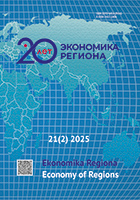Influence of Family Residence and Birth Order on Regional Fertility Rates (the Case of Udmurtia, Russia)
DOI:
https://doi.org/10.17059/ekon.reg.2025-2-13Keywords:
birth rate, fertility factors, the ratio of women and men, type of settlement, the birth order of children, mathematical modeling, correlation and regression analysisAbstract
This study examines birth rate dynamics in the Udmurt Republic from 2000 to 2023, focusing on how family residence (urban vs. rural areas) and birth order affect fertility. Understanding these factors is essential for tailoring effective regional demographic policies. Using regression analysis and prior correlation studies, the research identifies linear relationships between birth rates and variables such as settlement type, birth order, the ratio of average per capita income to the subsistence minimum, and maternity capital availability. A nonlinear relationship was found between fertility and the sex ratio of the fertile-age population. The study confirms that birth rate dynamics vary significantly depending on the place of residence and birth order. Mathematical models were developed to describe these dependencies and used to forecast fertility trends through 2030. Projections indicate a continued decline in first births, stabilization of second births, and growth in third and subsequent births, with the overall birth rate stabilizing around 7.2 per 1,000 people. By 2030, total births in the region are expected to decrease by 20.6 % from 2023 levels, largely due to an imbalance in the ratio of fertile-age women to men. These findings may provide a basis for developing targeted fertility enhancement programs tailored to specific territorial contexts.
Downloads
Published
How to Cite
Issue
Section
License
Copyright (c) 2025 Вавилова Дайана Дамировна , Кетова Каролина Вячеславовна

This work is licensed under a Creative Commons Attribution 4.0 International License.




